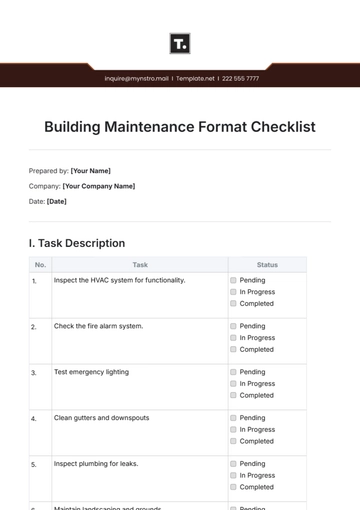Simple Cardiac Assessment Checklist
Prepared by: [YOUR NAME]
I. PATIENT INFORMATION
# | Task | Status |
|---|
1 | Record the patient's full name and age. | |
2 | Document presenting symptoms. | |
3 | Note the patient's medical history. | |
4 | Gather family history of cardiac issues. | |
5 | List current medications and allergies. | |
II. VITAL SIGNS
# | Task | Status |
|---|
1 | Measure and record heart rate. | |
2 | Measure and record blood pressure (both arms). | |
3 | Record respiratory rate and pattern. | |
4 | Assess and record oxygen saturation levels. | |
5 | Take and note temperature if relevant. | |
III. PHYSICAL EXAMINATION
# | Task | Status |
|---|
1 | Perform chest auscultation to detect heart sounds. | |
2 | Assess peripheral pulses for strength and rhythm. | |
3 | Check for signs of edema in extremities. | |
4 | Observe for cyanosis in lips, nail beds, or skin. | |
5 | Inspect the jugular vein for distension. | |
IV. DIAGNOSTIC TESTS
# | Task | Status |
|---|
1 | Conduct an Electrocardiogram (ECG/EKG). | |
2 | Schedule and perform an echocardiogram. | |
3 | Collect and analyze lab tests (e.g., troponin, cholesterol). | |
4 | Obtain imaging studies if necessary (e.g., chest X-ray, CT scan). | |
5 | Review results with the patient or team. | |
V. RISK FACTOR ASSESSMENT
# | Task | Status |
|---|
1 | Evaluate for smoking or tobacco use. | |
2 | Check for a history of diabetes or hyperglycemia. | |
3 | Measure and record Body Mass Index (BMI). | |
4 | Assess for hypertension and its management. | |
5 | Discuss lifestyle factors, including diet and exercise. | |
VI. CLINICAL NOTES AND RECOMMENDATIONS
# | Task | Status |
|---|
1 | Summarize key findings from the assessment. | |
2 | Provide initial treatment recommendations. | |
3 | Determine if a specialist referral is needed. | |
4 | Document patient education provided. | |
5 | Schedule follow-up or additional diagnostic tests. | |
Checklist Templates @ Template.net






























